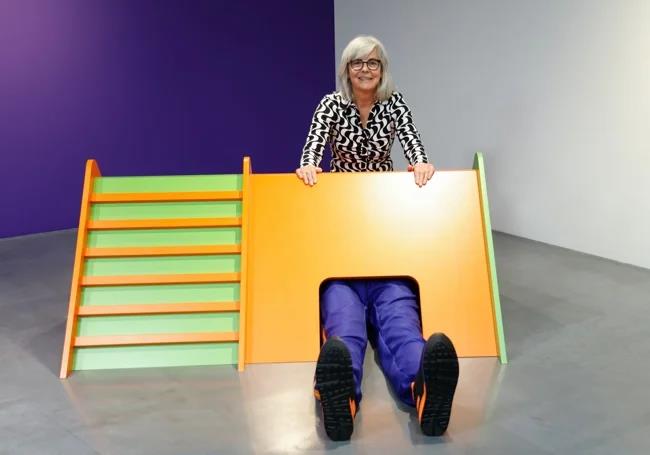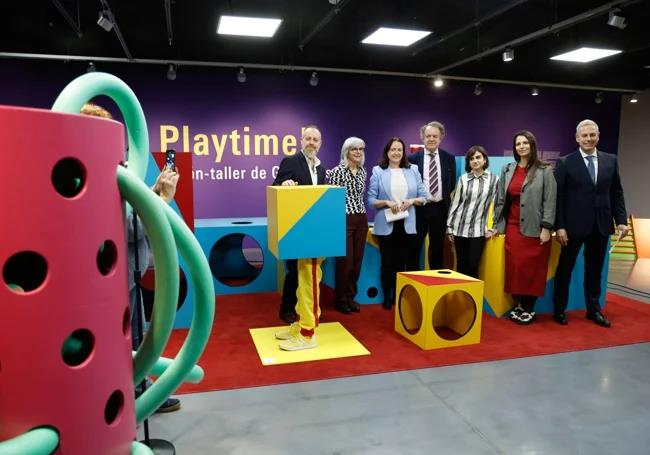Playtime at the Pompidou: the new creative proposal for kids in Malaga
The artist Guda Koster has designed seven play sculptures that invite children to experiment with textiles, shadows and shapes
They are designed for children, but Guda Koster, who is over 60, can be seen happily putting on the geometric dresses, playing with the shadows on the wall and sitting next to the 'Sleeping man'. It's really not that different from what she does in her street performances, only this time her target audience is a little bit younger. "You're never too old to play," she says. The Centre Pompidou Málaga has renovated its Espacio Joven, a playground for the younger visitors, with a project designed by the Dutch artist. 'It's playtime!' invites children from the age of 14 months to experiment with the shapes, shadows and textiles of seven 'sculpture men'. The installation will remain in the museum until February next year.

Only legs can be seen, lying on the ground, doing a handstand or standing upright. The rest of the body is hidden under something, an enigma that provokes the children's curiosity. It is part of the creative universe of Guda Koster, full of mystery and humour. "They don't know if they are men or women, if they are real or robots. This morning they were pulling up his trousers to see if he was a real person," laughs Guda Koster, who a few minutes earlier watched a group of schoolchildren interact with her installation. "And it's amazing because they do a lot more things than I would have imagined."
Each sculpture offers a different game. In 'Upside down', a skirt hangs over upside down legs creating a kind of tent, a place to shelter and hide. 'Sleeping man' encourages children to climb up his legs and the wooden structure that covers him. In 'Out of the box', the child becomes one of these sculptures, revealing only his head or his arm through a tunnel created by a row of boxes. There are no rules or established routes, everyone interacts with the elements in their own way.
With 'Stickyman', children experiment with shapes and textures with different felt figures that are glued to a surface. In 'Noodleman', they have fun fitting the foam tubes through the holes in the sculpture, thus composing a man with a thousand arms. Guda Koster saves her favourite part for the end: the costume corner, 'Dressman'. She says that she has had a soft spot for textiles ever since studying at art school. "Their texture is something very human, soft and powerful at the same time," she explains. She has created the costumes that hang on the coat rack, geometric designs with volumes and movement for children to try on and play with. Circular dresses, sleeveless tops and accessories in all colours, like the ones she wears in her performances and in the photos that now decorate the Espacio Joven. Next to it, 'Shadowman' offers different objects to make shadows on the wall behind.
Guda Koster aims to encourage children's creativity, not only because it brings them closer to art, but also because it helps them to find solutions to a variety of problems. Creativity can be harnessed in many ways. As the daughter of a garbage collector and a housewife, she grew up in a home with no ties to the art world but a teacher encouraged her to try new things. "This is a space for discovery, for families to interact...there is room for entertainment, joy, enthusiasm, laughter and also mystery," said Alizée Sabouraud, project manager. Joining her at the presentation were Mariana Pineda, the city councillor for culture, Luis Lafuente, director of the agency that manages the municipal museums, Juan Carlos Barroso, territorial manager in Andalusia, Ceuta and Melilla of the Fundación la Caixa and Antonio Caballero, director of CaixaBank's business area in Malaga.

As Lafuente recalled, this is the fifteenth exhibition for children to open in the Pompidou Malaga's 10 year history but it is the first designed for children of such a young age, from 14 months to 6-7 years (until now it was for children aged 4 years and upwards).
Guda Koster admits that she was "taken aback" when she was approached to lead the project, as she had never worked for a younger audience before. But she decided to be true to herself and her style. "Why the legs? I don't know, maybe because when you see them you think they're going to move," she says, before laughing, like a child.

-U82538401164OvU-1200x840@Diario%20Sur.jpeg)